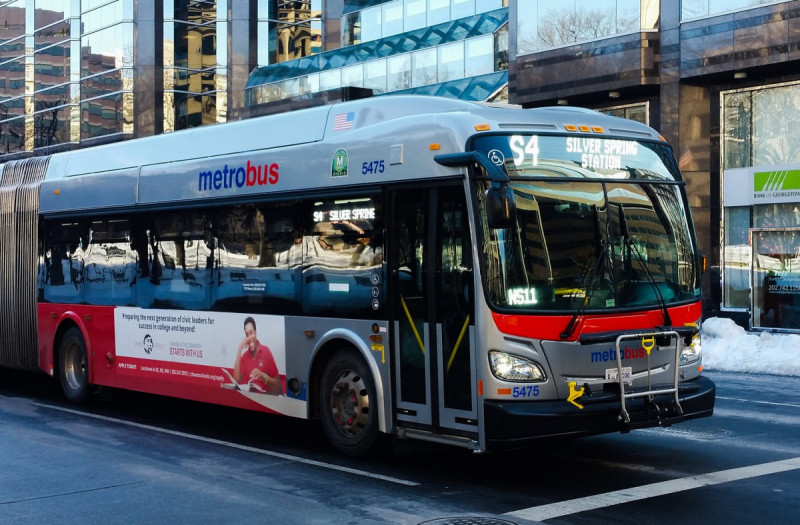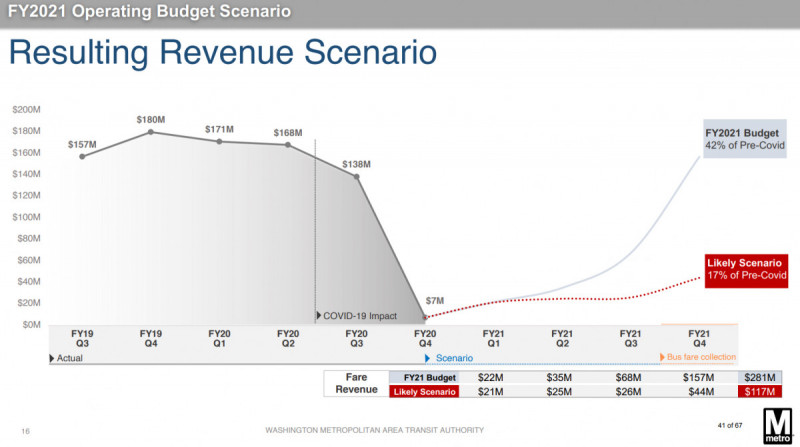Metro’s newest budget is grim, dire, and insert-your-negative-adjective-here

A Metrobus by BeyondDC licensed under Creative Commons.
Metrobus service after midnight might end, 39 routes could be cut, and trains would run less often and for fewer hours if Metro doesn’t receive additional federal funding to fill the budget gap created by COVID-19.
Metro says it needs to cut hundreds of millions of dollars from this and next years’ budgets, and much of those savings come from running fewer buses and trains beginning as early as January.
You can get a detailed view of the cuts and changes here.
Graphic showing Metro’s original and updated revenue projections for the current fiscal year. Image from WMATA. 
One could say there was a fatal flaw in Metro’s original response to the novel Coronavirus pandemic: the assumption that the United States would quickly contain and deal with the virus, leading to a drop in travel and revenue, but resulting in a reasonable ridership rebound on the other side.
Quick containment didn’t happen (keep wearing your masks!), and Metro’s finances for the current fiscal year, which began in July, is worse than the agency expected. “…the ridership outlook for the remainder of FY2021 is much lower than was assumed in the May approved budget,” agency staff note in a Board presentation given on Thursday, September 10.
Letourneau: without additional fed $$, "there will be no way to avoid significant pain"
— Stephen Repetski (@srepetsk) September 3, 2020
Metro’s current FY2021 budget estimated that ridership would return to 48% of normal levels by the end of the fiscal year which ends in June, 2021. Four months later, Metro now estimates only 20% of its riders will return — which the agency says translates to a decrease of $203 million in revenue.
Metro’s rosiest ridership picture for FY2022 (July 2021-June 2022) is that ridership remains below normal — 50% at most — and the agency needs to cut just $379 million from the budget. It’s bleakest forecast of just 25% ridership results in a need to cut $569 million.
CARES funding to run out this year, and potential service cuts
The federal government passed a funding relief bill earlier in the year which, among other things, provided Metro with $876.8 million. The agency now says it’ll burn through that money by January.
More money from the federal government doesn’t seem to be on its way, either. “Right now the prospects do not look great,” quipped Metro Board Chairman Paul Smedberg in a video call with the Riders’ Advisory Council.
MD Transpo Sec. Greg Slater says the situation is complex and challenging. Says even MD's six-year plan for transpo projects slashed by $2.9 billion. So feeling it everywhere.
— Jordan Pascale🎙️ (@JWPascale) September 10, 2020
Lists several transit agencies w/ cuts: NYC, Denver, LA, Tampa, Vegas. "We're in a bit of a crisis."
Metro says it can save $42.6 million internally and defer $30 million in capital projects from the current year, but will need to cut $139.4 million in service.
Part of that $42.6 million of internal cuts is the elimination of some station manager positions. Instead of one station manager at each entrance, there would be just one per station. Details of the proposal are still in flux, said Peter Cafiero, Metro’s Managing Director of Inter-Modal Planning, and it’s unclear if this proposal would result in the closure of unwatched Metrorail station entrances.
Other cuts Metro says it can make include payments to its MetroAccess contractors and to internal staff. The agency has been using its CARES Act funding to pay its paratransit contractors so they didn’t have to lay off employees, but that extra funding would now end. Internally, Metro says it might have to furlough or lay off non-union employees, a separate, additional cut above those the agency will make if it cuts bus and rail service.
Image showing how Metro says it can cut service to save money. Image from WMATA. 
Metro has come up with six ways through which the agency can save $159.8 million between January and June — $20.4 million more than the minimum “needed,” so there’s some wiggle room.
Local jurisdictions are hurting too
Metro receives a significant portion of its budgets (both operating and capital) from local and state jurisdictions, but those are hurting for money now as well. $135 million of the CARES Act funding from the federal government was funneled by Metro to the jurisdictions which subsidize the agency, essentially as a “credit” to reduce how much the jurisdictions paid for Metro for the FY2021 year.
That one-time credit helped, but isn’t enough to cover ongoing pandemic-exacerbated issues. Virginia, for instance, is awaiting a budget amendment to pass to give the state flexibility to move money around such that they can pay their Metro bill, otherwise it might come up short.
Train departs Van Ness-UDC station by Ben Schumin.
Rail cuts and layoffs
On the rail system, Metro says it can save $29.7 million by running trains less frequently. Trains would run every 12 minutes all day instead of running more frequently during morning and evening rush-hour periods. The agency would lay off 493 people as a result. Trains would stay running as they are now on weekends: every 15 minutes on all lines, except Red which runs every 12.
For a $2.8 million savings, half of all Red Line trains on weekdays would also run only between Grosvenor and Silver Spring, a practice Metro only fairly recently got rid of and, once eliminated, led to a ridership increase. On the Yellow Line, all trains would run only between Huntington and Mount Vernon Square instead of running all the way up to Greenbelt.
Turning the rail system off at 9pm from Sunday to Thursday, and 11pm on Fridays and Saturdays, would save Metro $5.5 million, it says. The agency cut late-night rail service back in March and only restored the 9-11pm hours in mid-August.
Last, but not least, Metro proposes that it can delay the opening of the Silver Line. Pushing the opening out of the FY2021 budget year to July 1, at the earliest, would save the agency $53.8 million. Metro had hoped to be able to open the Silver Line around March of 2021, although some serious problems remain to be resolved before it can open safely.
Bus cuts
For a small increase in revenue, Metro wants to re-open the front door of its buses to riders and begin requiring paid fares again. Moving up fare restoration from April to January would increase revenue by $5.6, Metro says, over its previous budget estimate.
The largest savings in its FY2021 budget proposal would come from bus cuts. Metro says if bus service is never fully restored, and remains at its current partially-restored levels, the agency would save $62.6 million.
After some service was restored in August, about 75% of buses run every weekday, and 85-90% run on weekends. Metro has selected 39 routes which it suggests could be cut, and service reduced (from pre-pandemic levels) on a significant number of other bus lines.
There will be a public hearing
Service changes of this magnitude mean Metro will need to hold a public hearing to garner feedback so the agency can implement some of these changes by December. Given the accelerated timeline of the schedule, the public comment period might be a bit more unusual.
Local jurisdictions and political leaders, which typically have time to weigh in and negotiate more behind-the-scenes, will have the same limited opportunity as members of the public to advocate their positions.
The hearing is expected to be virtual and held in October or November, and Metro should be publishing more how to provide your feedback closer to when it’s held.
